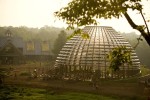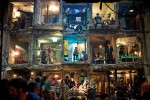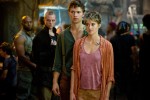The Creation and Design of Insurgent’s New Visual World
In a new article by the New York Times, the creation and design of the new visual world we see in Insurgent, as opposed to Divergent, is analyzed. Each faction has its own distinct visual qualities, but the most prominent ones are Amity and Factionless with their utopian and steampunk styles, respectively. Read below to get a sneak peek at how Insurgent’s visual world was imagined and then recreated, from Amity to Factionless:
…Much of the creative approach differed from the first film, with the directing baton being passed from Neil Burger to Robert Schwentke, and production design duties moving from Andy Nicholson to Alec Hammond (“Donnie Darko,” “Non-Stop”).
“When we were designing all of these factions, we had specific conversations about each faction having its own visual identity,” Mr. Hammond said by phone from Atlanta, where he was working on “Allegiant,” the next film in the series.
Amity and Factionless — each on screen for the first time — couldn’t look more different. One is a bright, agrarian utopia. The other is a dark, gothic, makeshift world underground.
Amity’ distinct look with their farms and big greenhouses, was designed to be in perfect contrast to what was coming their way with Tris, Four, Peter and Caleb’s arrival.
“We wanted to make sure that it felt like a working place,” Mr. Hammond said. To convey the mores of a community focused on peace and service, the designers settled on a circle motif.
“We wanted the dome also to be virtually indistinguishable from the landscape and the environment around it,” he said. The top is made from frosted glass, and the bottom is open air. Lines along the interior create a spiral that wraps around the dome, creating a circular connection between land and architecture.
“It’s idyllic in many ways, and we wanted it to feel that way because it’s a world that is alien to Tris,” Mr. Hammond said. The character arrives at Amity angry and shaken, so the peacefulness in the design contrasts with her emotional state.
Factionless, on the other hand, was designed to look like a fully functioning community, contrary to what other factions believed they were, scattered nomads.
“There had to be something in the set that allowed you to believe that this could be literally underground and never be noticed from anybody above,” Mr. Hammond explained. “We kept coming up with these oddly shaped cubicle ideas, trying to find infrastructure that would suggest that. We looked at storm sewer runoff drains, large-scale water systems underneath cities.”
Those provided the basis for this almost “Hollywood Squares”-style living quarters, where a collection of concrete panels stacked on top of one another open up to a central area. The set was built on a soundstage in Atlanta and dressed with all manner of repurposed items. Each small space has its own personality.
“They’re the faction of scavengers, the faction of make-do,” Mr. Hammond said. “We tried to show that with light, the kinds of fixtures they had.” The idea, he added, was that it would look nothing like, say, the organized aisles of Home Depot.
They changed the lighting schemes using different translucencies of plastic and also some natural light sources, holes where shafts of light could creep in from above.









Recent Comments